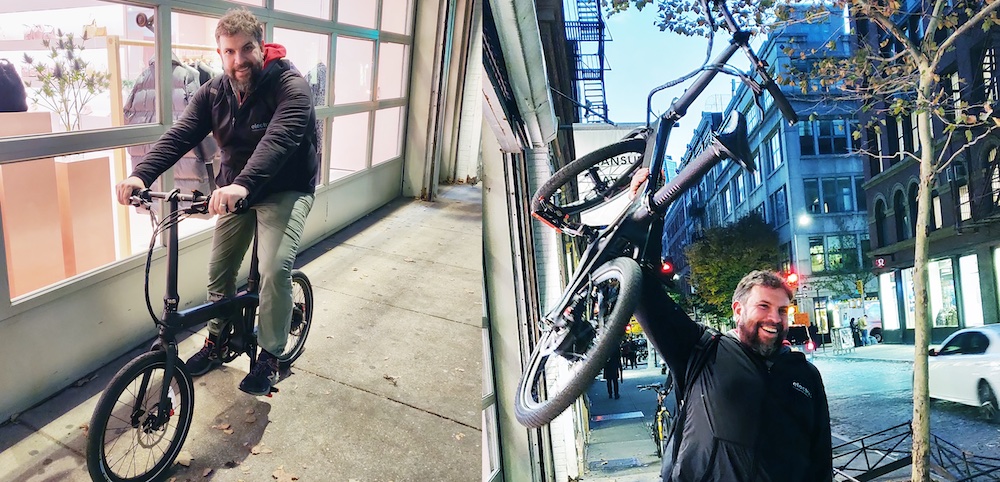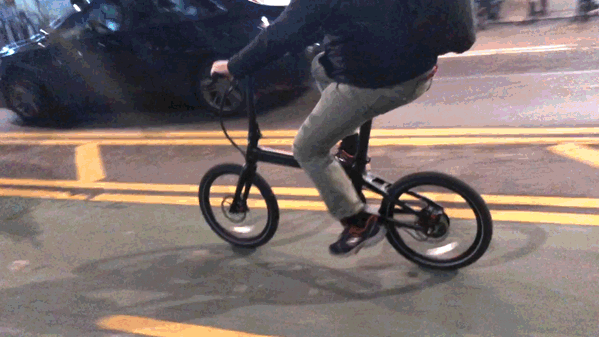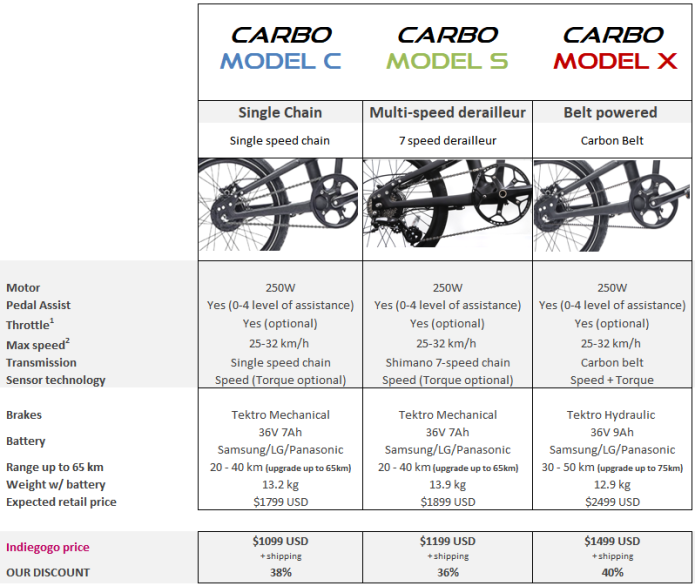
When looking for the perfect ebike, there are a lot of things to consider. There’s price, weight, capabilities, performance and something that’s hard to quantify: feel. That’s a combination of factors that is affected by the geometry of the bike, its materials, components and other nuances. I took a ride on the crowd-funded Carbo folding bike this week and I’m not sure I’ve ever felt as comfortable on a folding bike in the city as I did on this extremely light, yet powerful ebike.
Yes, unfortunately you can’t buy Carbo at Amazon yet – it is an Indiegogo crowdfund which of course makes its chances of arriving at your doorstep a little less likely. But, that being said, I don’t think I’ve ever hoped for a bike to make it to market as much as the Carbo.
This bike is $1200 – $1600 + shipping depending on whether you want a chain, chain mult-gear or single speed belt drive as well as optional hydraulic vs. manual brakes and a 7-9Ah battery.
By comparison, the similarly priced budget e-Joe bike that I reviewed earlier this year is a clunky relic at 50lbs. The Carbo weighs about half of that and has higher quality components for a lower price. One of the best foldable ebikes I’ve ever ridden, the Tern Vektron, costs and weighs almost double at $2700 and 48lbs. The $1000 Sondors Fold is 55lbs.
What is Carbo?
Carbo is a carbon fiber ebike designed around being incredibly light weight, yet somehow still remains fast, easily foldable and strong. I spoke with co-founder Lyne Berro about the genesis of the bike while we rode through New York City from Soho to Times Square (she was insanely driving a powered unicycle weaving through traffic).

The idea is that if you make a foldable bike light enough, all of a sudden you can take it more places. You can bring it to your office or your 4th floor walkup, ride with it on the train/bus or simply leave it in the truck of your car without nearly as much hassle as the heavier and bulkier bikes that play in this genre.
Carbo Fiber
How do you get a bike this light – down to 12.9kg/28.5lbs – without sacrificing quality of components or price? That’s the secret sauce to Carbo, but I think a huge part of it is getting the price of the carbon fiber frame down. They’ve done this by designing their own Japanese Toray carbon fiber frame with the help of their Asian suppliers. I learned that carbon fiber isn’t wildly expensive, it’s just that doing it right is very difficult.

One ride on the Carbo prototype showed me that they learned how to do carbon fiber right. It doesn’t ride too stiff and is incredibly solid, but with some give on bumps and hard moves.
It isn’t just the frame though. Every component on this bike is optimized for weight. The motor is the lightweight and value Bafang 250W (upgradable to 350W). I’m usually underwhelmed by 250W ebikes, but with the light weight of the Carbo, this motor gets up to ~20mph speed fairly quickly either via pedal assist with torque and speed sensors or throttle.
Carbo Battery
One of the unique aspects of the Carbo is the battery placement. We’ve seen plenty of bikes hide their batteries in downtubes, but Carbo actually turns the seat post into a large 36V 7-9Ah battery (252-324Wh) bar with a USB port below the seat. While the placement isn’t optimal for charging your phone while riding (unless you leave it in your pocket), it does make for a cool USB-powered rear light option. The seat post has a noticeably wider diameter to house the 18650 batteries that will be sourced from top-tier companies like Samsung, LG and Panasonic.
Although the battery is relatively small for an ebike, the light weight will help you get anywhere from 20-50 kilometers (12-30 miles) depending on rider weight/contribution and battery options. Carbo says that this also helps with the weight distribution, but at first glance, it would seem to be a higher center of gravity than most ebikes. Like I said before, riding the carbo feels great which is the bottom line here.
Carbo Components
Carbo is saving weight in a few places here without skimping on components. The bike geometry and folding is reminiscent of the Dahon folding bike which is loved by commuters. Incidentally, a typical non-electric high quality foldable Dahon is about the same weight (27lbs.) as is a Brompton with 16-inch wheels (25lbs.). That puts the Carbo into perspective.
The belt drive of the high-end Carbo is also a weight saver over the chain driven models, but Carbo also saves weight on the kickstand by using an ingenious, pedal mounted kickstand.
Disc brakes are Tektro mechanical with hydraulic option. Tires are soft Schwalbe with puncture resistance. If you choose the 7-speed, you get a Shimano cassette.

Add-ons include extra seat posts with or without batteries, rear rack for storage and fenders for puddles, the torque sensor 350W bafang motor upgrade, carry bag and even an extra internal battery that will fit in the front (but add significant weight).
Carbo Airports
Because Carbo’s seatpole battery is so small, it will soon be allowed on carry-ons for flights so you can actually ride to the airport and ride home if you are travelling light.
Carbo Concerns
I’m not an expert on carbon fiber, but I have seen a few of my friends crack their $5000 carbon fiber road bike frames. One was on a relatively minor road accident and another was in a bike shop when being fixed with grips that were too strong. When carbon fiber cracks, it looks more like glass than aluminum and it is really game over for that frame. I would be afraid of hitting the frame against something very hard and basically breaking the Carbo, especially in the city. The upside is that all of the components are easily transferable to a new frame.
Also, there is the typical crowdfunding concern that these guys will just take your money and run. However, I have actually met this team and they seem extremely dedicated to making this product work. It feels like they have a very bright future and are already 2/3rds of the way to $1M in funding. Could something happen that kills this bike before shipping in April? Sure, it is mostly Chinese at the moment and it feels like the 25% tariffs are just the beginning of an escalating trade war.
Carbo Price
This is where the Carbo folding ebike is impressive. At under $1500, these bikes compare with non-motor folding bikes not just in weight, but also in price. I expect once the Indiegogo campaign ends, these bikes will shoot up in price over $2000 since there isn’t anything else like them on the market.
Add $100 to the below prices:

Wrap-up:
The Carbo folding ebike has so much potential in the foldable ebike field. What you get is basically a top quality foldable bike price and weight but with a solid battery, motor and electronics thrown in without any additional weight or costs. Magic? Maybe. I only got to ride a prototype, but it was an exceedingly great experience and if they can actually make these things, I think they will be exceedingly popular. Sign up here, the campaign ends in just one week.
FTC: We use income earning auto affiliate links. More.
Subscribe to Electrek on YouTube for exclusive videos and subscribe to the podcast.





